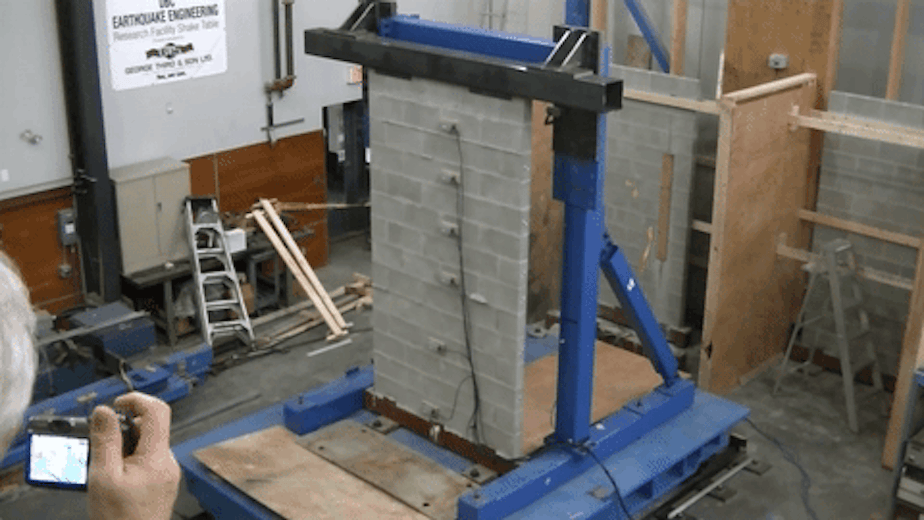How to save that old building from a megaquake? Try spray-on concrete

Seattle has 1,100 old brick buildings that are especially vulnerable to collapsing in a big earthquake. Few have been retrofitted to withstand a major seismic event.
Now researchers at the University of British Columbia say they’ve come up with a cheap, fast way to reinforce such buildings: spray them with bendable concrete.
They say their spray-on, fiber-reinforced concrete will let these old buildings survive even the biggest earthquakes.
When hit with enough force, concrete is brittle like chalk. A video from UBC shows a concrete wall shaking in a "shake table" test until it collapses in pieces on the floor.
But with a 0.4-inch layer of the new concrete sprayed onto it, the researchers got a very different result: The coated wall bends instead of breaking.
Sponsored
It even survived shaking twice as strong as the big Cascadia subduction zone quake that’s heading to our region some day, maybe very soon.
"We shook it and shook it and could not fail it," UBC engineering professor Nemy Banthia said.
Banthia said the spray-on, bendable concrete is much less expensive than other seismic retrofits and could be widely used both locally and in nations like China and India, where unreinforced masonry buildings are common.
The seismic concrete will get its first real-world application later this month when it will be sprayed onto Annie B. Jamieson Elementary School in Vancouver, B.C.
"We have 346 schools in British Columbia built with unreinforced partition walls that will all tumble in a large earthquake," Banthia said.
Sponsored
“Other people have done similar things, applying sheets of fiber directly to the faces of walls, with fairly similar results,” civil engineering professor John Stanton of the University of Washington said. “It may be easier to spray the concrete on.”
“Anything you can do to save these unreinforced masonry walls will be great,” Stanton said.
Cost has been Seattle building owners’ main objection to making their historic buildings safer.
The potentially deadly risk of unreinforced buildings pancaking onto themselves has been known for decades. The Seattle City Council passed several ordinances requiring seismic retrofits on unreinforced masonry properties in the 1970s. But building owners balked at the cost, and the requirements were repealed.
King County's former head of emergency management calls unreinforced masonry structures "killer buildings."
Sponsored
Currently, the Seattle Department of Construction and Inspection estimates that retrofitting all unreinforced masonry buildings in the city would cost up to $1 billion.
In July, an advisory committee to the department recommended that owners of unreinforced masonry buildings be required to retrofit them within seven to 13 years.
Ash not trash
UBC's seismic concrete is made mostly from waste: 70 percent of it is ash from coal-burning power plants. Most of that coal ash, one of the world's most abundant types of industrial waste, gets dumped in landfills or rivers, with smaller amounts incorporated into concrete or drywall.
Using the ash isn't essential for the seismic benefits, Banthia said, but it helps keep down costs and climate impacts.
Sponsored
Regular concrete is hard on the climate: 7 percent of global greenhouse gas emissions comes from manufacturing cement (which is mixed with water and sand or gravel to make concrete). Every ton of cement produced generates nearly a ton of carbon dioxide.
The Ash Grove Cement plant, by the West Seattle Bridge, is the city’s single largest source of greenhouse gas emissions, according to the city's latest greenhouse gas inventory.
"Fly ash," the lightweight portion of coal ash used in the concrete, is mostly silica (the main component of sand), but also contains heavy metals like mercury and cadmium. It can damage the lungs in its loose, powdery form. When encapsulated in products like concrete or wallboard, it does not pose a health risk, according to Banthia and the U.S. Environmental Protection Agency.
Unreinforced masonry buildings in Seattle
• Critical vulnerability: 77 schools, hospitals, fire stations
Sponsored
• High vulnerability: 183 buildings taller than 3 stories on poor soil or with more than 100 occupants
• Medium vulnerability: 902 buildings bigger than duplexes
SOURCE: Seattle Dept. of Construction and Inspections
John Ryan loves getting tips and documents. He can be reached at jryan@kuow.org or on the encrypted Signal or WhatsApp apps at 1-401-405-1206 (whistleblowers, never do so from a work or government device, account or location). For greatest security, use KUOW's SecureDrop portal. Snail mail is also a safe way to reach him confidentially: KUOW, 4518 University Way NE #310, Seattle, WA 98105. Don't put your return address on the outside.

